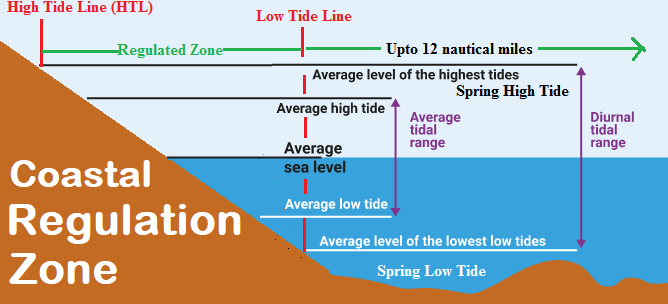The Comptroller and Auditor General’s (CAG) Report on the Conservation of Coastal Ecosystem of India was was tabled in Parliament as a report on whether steps taken by the Union Environment Ministry to conserve India’s coastal ecosystems have been successful.
Findings of ‘performance audits’ of Conservation of Coastal Ecosystem from 2015-20:
- National Coastal Zone Management Authorities (NCZMA) is still functioning as an ad-hoc body: Thus, impacting consistency in coastal conservation
- Delay or non-existent State/UT Coastal Zone Management Authorities (SCZMA):
- g., Karnataka has still not constituted it while Goa, West Bengal, and Odisha have delayed its reconstitution. In Andhra Pradesh, District Level Committees were not even established
- Several projects approved despite the EIA report highlighted inconsistency: Incidences of illegal construction activities (reducing coastal space) and effluent discharges from local bodies, industries, and aquaculture farms
- Other issues in EIA: non-accredited consultants preparing the EIA, using outdated data, and not evaluating the environmental impacts of the project
- Expert Appraisal Committees not being present during project deliberations.
- Members of the EAC were fewer than half of the total strength during the deliberations.
- State-level issues:
- States haven’t yet prepared Integrated Management Plan for Critically Vulnerable Coastal Areas.
- Tamil Nadu didn’t have a strategy in place to conserve the Gulf of Mannar Islands.
- Goa: there was no system for monitoring coral reefs and no management plans to conserve turtle nesting sites.

Recommendations:
- NCZMA and SCZMA be made permanent
- Proper ecological evaluation before granting clearances
- Preparing detailed map and management plans for coral reefs, turtle nesting sites, etc.
Background of Conservation of Coastal Ecosystem
Conservation of coastal areas is governed under the Environmental Protection Act of 1986. The Coastal Regulation Zone Notification (CRZ) 2019 classifies the coastal area into different zones to manage infrastructure activities and regulate them.
The three institutions responsible for the implementation of the CRZ are:
- National Coastal Zone Management Authority (NCZMA) at the Centre
- State/Union Territory Coastal Zone Management Authorities (SCZMAs/UTCZMAs) in every coastal State and Union Territory
- District Level Committees (DLCs) in every district
These three bodies examine if:
- CRZ clearances granted by the government are as per the procedure
- Project developers once given the go-ahead are complying with conditions
- Project development objectives under the Integrated Coastal Zone Management Programme (ICZMP) are successful.
What Is a coastal regulation zone?
- The coastal areas of seas, bays, creeks, rivers, and backwaters which get influenced by tides up to 500 m from the high tide line (HTL), and the land between the low tide line (LTL) and the high tide line have been declared as coastal regulation zone (CRZ) in 1991.
- The coastal regulation zones have been declared by the Ministry of Environment, Forest, and Climate change under the Environment Protection Act 1986.
- While the CRZ Rules are made by the Union environment ministry, implementation is to be ensured by state governments through their Coastal Zone Management Authorities.
Shailesh Nayak Committee Report on Coastal Regulation Zone
- The Shailesh Nayak committee was constituted in June 2014, and it submitted its report in January 2015.
- The committee recommended the relaxation of the terms set up by the CRZ 2011 notification.
- The major objective behind the recommendations was to boost tourism, port construction, and real estate.
- The committee suggested diluting the regulatory powers of the Central Government in the coastal areas.
- Except for those activities which require environmental clearances all other activities should fall under the ambit of state and local planning bodies.
- Based on the recommendations of the Shailesh Nayak committee, the suggestions were given by the coastal states and union territories, and the CRZ 2018 notifications were issued.
.
You Can Follow on Youtube – Score Better
Also, Read More Articles on the Environment & Ecology
Join Us on Telegram For More Updates
.
